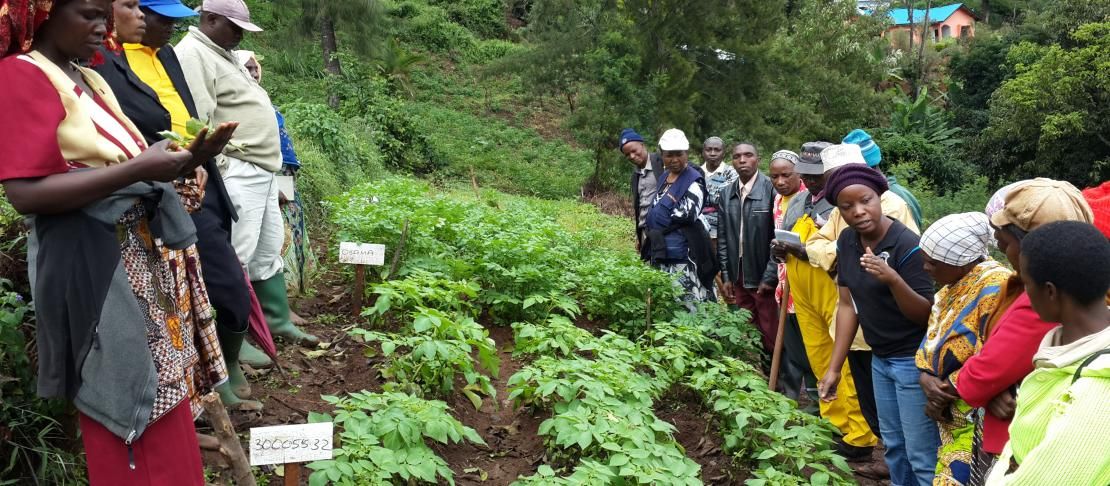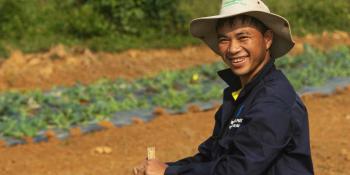Improving potato yields for farmers in the Usambara Highlands

Action research by a number of partners promises to deliver better potato varieties for smallholder farmers in the Usambara Highlands in Northern Tanzania.
An ongoing, but promising, study in the densely populated Lushoto district, Northern Tanzania aims to empower farmers to plant potatoes year round while increasing yields. Preliminary findings show that advanced clones and improved varieties that include Asante, Shangii and Obama, currently being tested, outperform local varieties, such as Kidinya, in terms of resistance to potato late blight disease.
Potatoes are one of the most important food crops grown in sub Saharan Africa. Indeed, a much higher proportion of sub Saharan African’s diet is made up of cereals, roots and tubers. The region’s population is set to double by 2050 and triple by 2100. Therefore, with current global trends in diets and population, 60 percent more food will be needed in 2050.
Access more Big Facts on Climate Change and Agriculture: Focus on Sub-Saharan Africa
Supported by the CGIAR Research Program on Climate Change, Agriculture and Food Security (CCAFS), East Africa, this study was initiated in 2013 and is led by the International Potato Center (CIP) in partnership with the Selian Agricultural Research Institute (SARI), Lushoto District Agricultural and Livestock Development Office (DALDO), YARA Tanzania Limited, Japan International Cooperation Agency (JICA) and local Non-Governmental Organizations (NGO’s).
Planting once a year
Out of six clones being tested, one got a score of 45 percent of the total vote against one percent for the local kidinya variety when it comes to resistance to potato late blight disease; which can occur at any time during the growing season. The disease is however more likely to be seen during cool wet seasons and spreads rapidly killing plants within a few days. In terms of preferences by gender, for improved varieties, men preferred Asante whereas Shangii was preferred most by women. The reasons for these preferences will be determined in subsequent trials.
The most important way of controlling late blight is to prevent its onset in the field – its control being very costly and thus less accessible to small-scale farmers when symptoms are already visible. Coming up with resistant potato varieties for use in the region is therefore a game changer” says Dieudonné Harahagazwe of CIP.
Lushoto district is part of the Usambara highlands of Tanzania where potatoes are traditionally grown. With an annual production of around 100,000 tonnes, the area produces more potatoes than some countries like Burundi, Democratic Republic of Congo or Mozambique (FAOSTAT 2013). However, most of the potatoes produced in Lushoto are local varieties among which ‘Kidinya’ is the most dominant. Farmers can only plant economically once a year, because this variety is sensitive to potato late blight disease and heat.
The research process
The action research model applicable in this study is intensive, as most of the partners involved in facilitation are also trainees. Tested by CIP for the first time in three districts of Mozambique, the approach consists of combining training-of-trainers (ToT) and participatory varietal selection experiments (PVS).
The ToT comprises five training modules that span two growing seasons, three modules during the long rainy season and two in the subsequent short rainy season. The topics covered in the first round of training are selected by facilitators in order to cover important components of crop management, from land preparation to seed storage. The second round of training is participant-led as topics emerge from the first round. In the present study, a total of twenty one participants representing farmers, extension services and NGOs attended the ToT.

farmers learn how to
detect POTATO Bacterial WILT using a glass of water from an extension officer. PHOTO: Dieudonné Harahagazwe (CIP)
The mother-baby approach is being employed in the trials. This entails testing all genotypes using standard on station experimental procedure with replications (called the mother trial), and having a set of farmers planting the same material (called baby trials). In this case, the mother trial was conducted at the Lushoto Resource Center and three villages (Kwesine, Boheloi and Maringo) ran the baby trials.
The best genotypes selected after two growing seasons will be submitted for official release prior to starting seed multiplication and dissemination. Seed dissemination in the villages will be accompanied with empowerment of end-users through Farmer Run Field Schools.
Lushoto is one of CCAFS Climate Smart Villages sites, where researchers, development partners, and farmers are testing climate-smart agricultural interventions. The aim is to boost farmers’ ability to adapt to climate change, manage risks and build resilience. At the same time, the hope is also to improve livelihoods and incomes and, where possible, reduce greenhouse gas emissions to ensure solutions are sustainable.
Read more about ongoing research in Lushoto: Better bean research for Usambara’s rural poor.
Dieudonné Harahagazwe is a Crop Ecophysiology and Modeling Scientist, International Potato Center, Kenya
Roberto Quiroz is the Interim Integrated Crop and Systems Research Program Leader, and Production Systems and the Environment Sub-Program Leader, International Potato Center, Peru
George Sayula is the Lushoto site team leader - he is a researcher with the Selian Agricultural Research Institute
Elmar Schulte-Geldermann, Cecilia Turin, Asrat Amele, Merideth Bonierbale, Victor Mares, Gladness Brush, Elizabeth Msoka, Mary Rimoy and Andrew Exaud are also contributing to this study.
Editing of this article was done by Vivian Atakos, Communications Specialist, CCAFS East Africa



